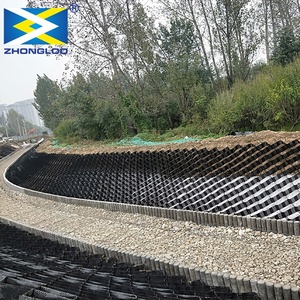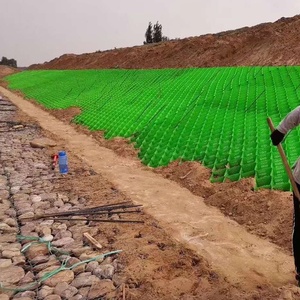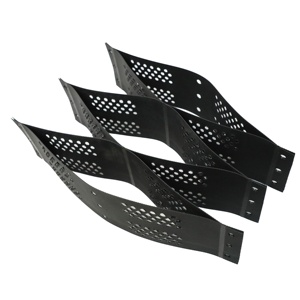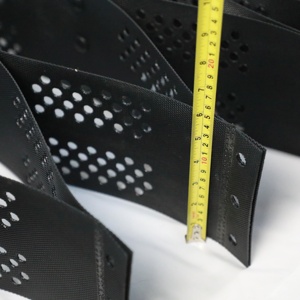
All categories
Featured selections
Trade Assurance
Buyer Central
Help Center
Get the app
Become a supplier

(6852 products available)














































Gravel stabilizer grids are categorized into two based on material used in making them. They are:
Gravel stabilizer grids are also divided into two according to their structure. They are:
Gravel stabilizer grids are used for different purposes. They include:
Gravel stabilizer grids are made of strong plastic, like polyethylene, which can hold up to a lot of weight. They are formed into hexagonal shapes that interlock with each other when filled with gravel. This shape helps spread the weight more evenly.
The stabilizer grids are light so they can be moved easily to the installation site. They are also flexible, which allows them to bend a bit when the ground moves but not break.
The stabilizer grids are made from recycled plastic, which is good for the environment. They are designed to last for a long time without breaking down due to the sun, heat, or cold temperatures.
Each grid has empty spaces in it that are filled with gravel, creating a hard surface. This surface can be used for walking, driving, or parking.
Because the empty spaces in the grid are filled with gravel, water can soak into the ground instead of running off. This helps keep the area green and prevents floods.
The stabilizer grids are placed directly on top of the grass or dirt to create a path or parking lot. Once they are in place, people can walk on them, cars can drive on them, and large trucks can park on them without the ground sinking or breaking.
Plastic grid stabilization mats are used to create a stable surface for various applications. Here are some common usage scenarios:
Driveways and Parking Areas
Driveway gravel stabilizer grids are placed under gravel driveways and parking lots to prevent gravel from moving around. The grids support the weight of cars while allowing grass to grow. This creates a green, permeable surface that absorbs rainwater.
Paths and Trails
Trailblazers stabilize paths and hiking trails with gravel grids. The grids reduce erosion from footsteps and protect the surrounding area. They are easy to install without tools using just gravel and a rake.
Emergency Landing Zones
Gravel landing zones can be quickly set up anywhere using helicopter landing gear. The grids make sure helicopters land safely on temporary locations.
Construction Sites
Construction sites often have muddy areas. Gravel and stabilizing grids create temporary, sturdy work surfaces that support heavy equipment. This prevents mud and damage to the ground.
Event Spaces
For outdoor events like weddings and festivals, organizers can use gravel and grids in open spaces that are muddy or bumpy. This makes a stable, even surface for guests and vehicles.
Utility Right-of-Ways
Utility companies sometimes use plastic grids and gravel in areas they maintain, like for power lines or pipelines. The combination provides a strong, low-impact surface that protects the ground while allowing access.
Vegetated Swales
Gravel and grids can also help manage stormwater runoff by slowing it down in the right areas. For example, they may be used in swales - channels planted with grasses and plants - that carry water.
Gravel stabilizers are easy to install and use. However, choosing the right product for the intended use is essential. Here are the tips for choosing the right gravel grid:
Consider the Load Capacity
The first thing to consider when buying a driveway gravel stabilizer is its load capacity. Different grids have different load capacities. For example, some grids can support pedestrian traffic only, while others can support light vehicles and even heavy vehicles. The load capacity is usually indicated in pounds per square foot (psf). Therefore, it is crucial to determine the amount of weight the grid will support before purchasing one.
The Type of Plastic
The type of plastic used to make the gravel stabilizer affects its performance. UV-resistant plastic is recommended because it prevents the grid from breaking or turning yellow due to exposure to sunlight. This is especially important for people living in areas with lots of sunlight. Also, the best gravel stabilizer is made from recycled plastic. This option is friendly to the environment and helps people reduce carbon waste.
Check the Drainage System
The main reason people use gravel is to allow water to run freely without pooling or causing flooding. Therefore, it is essential to ensure the grid has enough openings to allow for proper drainage. A great driveway gravel stabilizer should have at least 40% void spaces for optimal drainage.
Check the Installation Process
Another important factor to consider is how the installation process works. Most stabilizer grids are installed by interlocking them, but others are connected using pegs. It is crucial to consider the installation process and determine if the customer can install the grid independently or if they need to hire a professional. Customers who prefer DIY projects should choose a grid that is easy to install. On the other hand, customers who don't mind spending more money will hire a professional to install a more complicated grid.
Q1: How does a gravel grid for driveway work?
A1: A gravel grid functions by evenly distributing the weight of vehicles that drive over it. This spreads the pressure on the ground below, preventing sinking and creating a stable surface that allows grass to grow and water to pass through.
Q2: Can anyone install a gravel grid?
A2: Yes, installing a gravel grid is simple. Each piece clicks together like a puzzle. Then, one fills the empty spaces with gravel. Instructions are provided for how much gravel is needed and how to plant the right grass for one’s area.
Q3: Is a gravel grid strong enough for cars and trucks?
A3: Yes, absolutely. A gravel grid creates a surface just as strong as concrete or asphalt but with added benefits. It can handle the weight of cars, SUVs, and even larger vehicles while allowing for water absorption and natural drainage.
Q4: What maintenance is needed for a gravel grid?
A4: Very little maintenance is required. One should periodically remove any leaves or debris and use a leaf blower to clean the surface. Every few years, one can have a professional service power wash the grid and check the drainage areas.
Q5: How long does a gravel grid last?
A5: A gravel grid can last over 25 years if properly installed and maintained. Its longevity matches that of concrete or asphalt, making it a durable alternative for driveways and parking spaces.